Are Digital Audio Ads Worth The Hype?

Digital Audio Ads have exploded this year. It’s estimated that advertisers will spend $3.72 billion this year on digital audio advertising. So why all the hype?
What is Digital audio advertising? It’s all the ads you get that are just sound. For example, any podcast, Spotify or Pandora ad is Digital Audio. It’s expected that Digital Audio Ads from just podcasts will surpass a BILLION dollars in 2021 and that the average American will spend nearly 90 minutes a day listening to streamed music or podcasts by 2022.
What’s the advantage of using digital audio ads? They are a great way to connect with consumers through a channel that they enjoy. Due to the nature of podcasts and audio ads, it’s easy to target consumers that are likely to be interested in your product. And it is very cost effective, because the ad only plays if they are listening to music or a podcast. Digital Audio Ads are also a great addition to omnichannel campaigns!
Do you think you could incorporate Digital Audio ads into your campaigns?
3 Types of Alternative Black Friday Campaigns
Calling Black Friday the biggest shopping event of the year is an understatement. In 2019, consumers spent $7.4 Billion online alone. This year more than ever, online spending is expected to grow. What are some ways to stand out online this holiday season?
Instead of the usual ‘one-day-only % off’ sale, campaigns focused on other things can be a great way to set you brand apart, gain awareness, and increase conversions. Here are three examples.
#1 – the Anti-Black Friday.
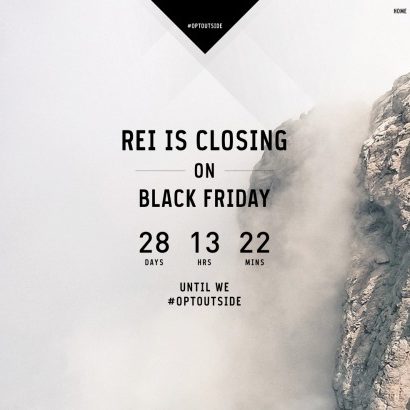
Taking a page from REI’s #OptOutside campaign, focusing on not buying anything on Black Friday can be very effective. Since 2015 REI closes on Black Friday and uses #OptOutside to encourage people to spend the day outside, which goes along perfectly with their brand mission and has helped grow their online community. Due to the longevity of the campaign and community it has created, the Opt Outside campaign helps increase REI sales year-round.
Another company using the Anti-Black Friday approach is the skincare company Deciem. In 2019, closed their stores and blacked out their website to protest the hyper consumerism focused Black Friday. Instead, their holiday campaign focused on “shopping slow.” For the entire month of November, every product was on sale. The longer, inclusive sale increased sales and helped reinforce their brand ideals with their customers.

#2 Highlight Your Mission
Many companies use Black Friday as an opportunity to show their customers what their brand ideals are. Donating to charities is a popular way. For example, Patagonia is known for alternative Black Friday campaigns but one especially effective one was 2016. They pledged to donate all their Black Friday sales to grassroot organizations that aligned with their brand goals. The campaign ended up generating $10 million in sales, over 5xs their goal!

The fashion company Kotn did something similar. Instead of sales, they promoted that they were going to donate Black Friday weekend profits to a charity that builds schools in Egypt, where the cotton used in their products is grown.
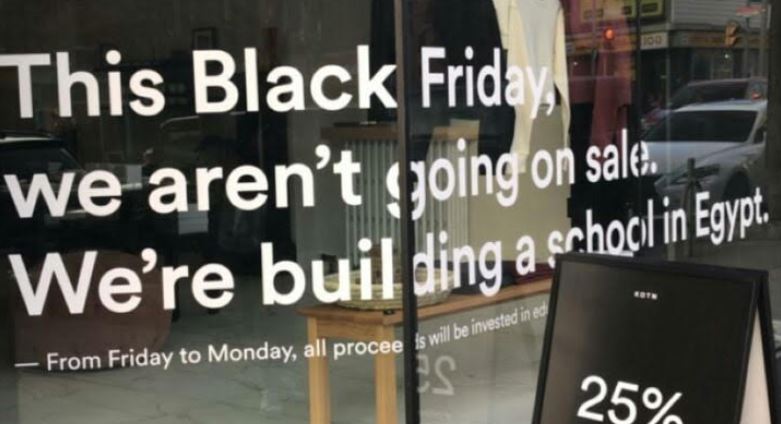
#3 Make it an event
A great example of this is MeUndies’ 2016 campaign. They promoted a Facebook live event for Black Friday. As more people joined, they unlocked more discounts and promotions. The event ended up with over 13,000 viewers and had a conversion rate of over 25%, which is 13x more than their average!
All of these brands used a day usually clogged with advertising to redirect their customer’s focus. They reminded people of their band mission and goals and helped strength their connection to their customers. What fun ways have you seen company handle Black Friday?
Can you use Geo-Fencing?
We often focus on how to optimize your website and other online presences. There are also many real-world ways to generate online traffic, such as geofencing. What is geofencing? And how can you use it grow your business?

Simply put, geofencing is virtual fence around a location. You can draw out this fence around any area that you think has potential customers. For example, you can geofence your brick and mortar store. You could also put a geofence around your direct competitor’s locations.

What happens after someone enters your fence? You can target that device with an ad, relevant deal, or offer. You can use geofencing to pull people into a location they are already close to. This works great for personal and localized content.
Geofencing is also great for retargeting. We are used to retargeting people who visiting our websites so it makes sense that we would also retarget people who visited us in person. This can increase returning customers and brand awareness.
Does geofencing work? YES! According to a survey done by OuterBox Design, more than 80% of surveyed shoppers said that they used their phones while in physical stores to look for products or to compare prices. That’s a lot of possible people to target! Also, campaigns that incorporate geofencing often show much higher click through rates and engagements.
What locations would you like to geofence?
How Can Data Help Multichannel Marketing?

Quality data and the proper interpretation is the foundation for any campaign. Especially for campaigns using more than one more channel or multichannel marketing. Customers now want personalized messages and interaction in the channel of their choice. The only way to do that successfully is have ongoing campaigns, spread out of many channels. How can data help?
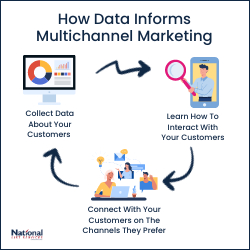
Step one for any campaign is to know your customer. Dig through all your first party customer data to create personas of your target customers. Knowing about your customers will help you figure out what channel they will mostly like to engage through.
It is helpful to give your customers and potentials multiple touch point options. Encourage your customer to sign up for emails, interact on social media, and any other engagement options. The more data you have on your customers, such as email, phone, social accounts, and their address the easier it will be to engage in a way that reaches them.
Next, you can collect data and analytics about your customers from the channels you are using to constantly to learn more about your demographics and your customer’s buying habits. The more channels you use the easier it will be to learn about your customer.
Knowing what channels your customers prefer can save you money. For example, there’s no point in sending your target audience direct mail if you know that’s not a channel that works for them. Therefore, collecting data about your customers can help you lower your CPA and give your faster ROIs.
How are you using data to inform your multichannel campaigns?
Want to learn more about how customer data can help your business grow?
What’s Working in Marketing- 2020?

Eleven months into 2020, it is safe to say, this year has had a lot of surprises. So, what has working in marketing this year? Here is what we have found:
1) Customer Experience driven marketing. This encompasses a lot of things. The main things that we have found to be successful in 2020 are brand storytelling and personalization.

Our brain is literally wired to seek out and respond to narratives. And no matter what is happening around us, that isn’t going to change. We are going to connect and respond better to brands that tell us a story and bring us along on a journey. How are some companies implementing this strategy? YouTube series, podcasts, active social medias are popular first steps. (Learn more about customer journey’s here.)
Personalization is a big key in reaching your customer’s heart. Using the customer’s name in things like email subject lines is a good first step. Beyond that you can use audience segmentation to separate your audience into groups that share common characteristics like demographics and behavioral information. Using your audience segments to target your message to things that each group are actually invested in can greatly increase how personal your marketing will feel to the customer.
Utilizing Multi and Omni channel marketing strategies will also increase how smooth your brand experience is for your customers. (Learn more about building audiences here and here.)
2) Email. More than 50% of people in the US check their personal email over 10 times a day. Most people say that it is their preferred way to communicate with brands. Although “the end of email” has been threatened may times in recent years, 2020 has shown us that email isn’t going anywhere soon. For many companies, email became the only way they could communicate with their customers this year.
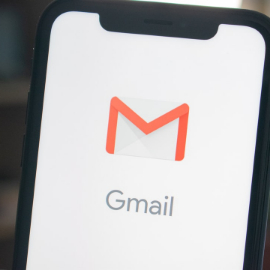
That means the margin for error with sending emails is relatively small. So. don’t forget to preview your email with different providers and devise before your send!
(Here are more email tips and tricks.)
3) Responsible consumerism and business practices. More than ever, consumers are aware of the effect their purchases have on the environment and on society and they want to buy from companies whose values align with theirs. People expect companies to actively fight injustices and be visibility support causes.
What has worked for your marketing this year?
Should You Care About Social Media Analytics?

There are over 3.8 billion people on social media around the world. That’s a lot of people to advertise too, and a lot of businesses to compete with. That’s why using social media analytics is so important.
What are social media analytics? Social media analytics is all the data about your customers the social media platforms are gathering. Combining the data from multiple steams and platforms can give you a lot of information about your customers.
Here’s are some things you can learn:
- – What platforms your customers prefer to engage on
- – What content do your customers enjoy most
- – What type of campaign or advertising works for them?
- – Do they have any other hobbies or interests?
- – More specific customer analytics, such as age or gender
What have your learned from your social media analytics?
What’s Your Customer Journey?

In 2020 we have lost many personal or face to face connections with customers. Therefore, digital marketing has to feel more personal. How? Focusing on your customer’s journey is the first step.
What is a customer journey? The customer journey is the order of all of your customers interactions and experiences with your company and brand. It is often illustrated in map form.
How can you build a customer journey?
Step one, who are your current customers? Analyze your first party data. What does your average customer “look” like? What is their age, gender, occupation? Do they have any specific interests or hobbies?
Step two, who are your potentials? Once you know who your average customer is you can build a look-a-like report to gain more prospects. (What is a look-a-like report? Get more information here.)
Step three, map their journey. How do they first hear about your brand? What are going to be their first interactions? What happens before they buy something? What happens after?
Here’s how that could be illustrated:
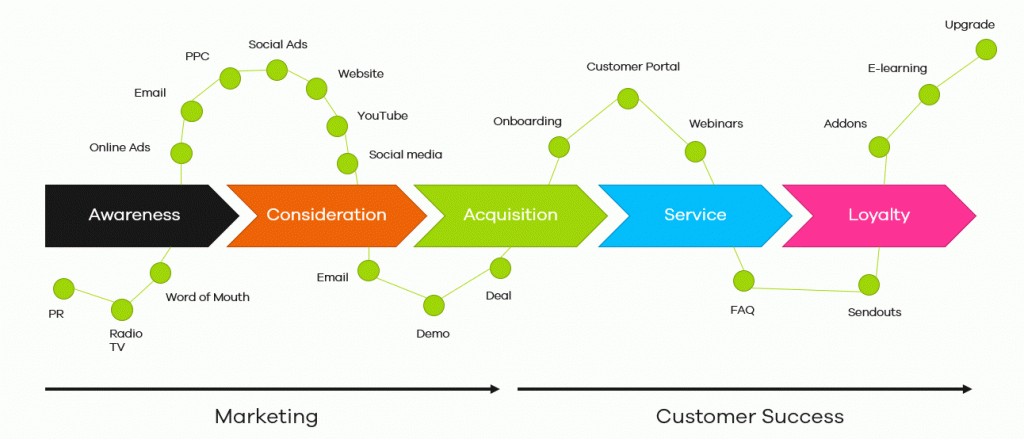
Blast marketing campaigns aren’t nearly as effective as they used to be. Building a campaign based on your customer’s journey can greatly increase your conversions and long-time customer loyalty. (One study found conversions were boosted over 300%!)
How can you use customer journeys?
How To Digital Advertise Effectively

With things changing around us so quickly, having a long-term advertising strategy can be a challenge. We need real time audience data as much as possible. How can we build an adaptable audience in this rapidly changing world?
One of the biggest changes in advertising this year was the extreme shift to digital. In an eMarketer poll, 56% of people said that they increased their online shopping this year. And 14% said that they shopped online for the first time. The way we shop has also changed. Because of the increase in online shopping, we tend to make faster, more impulsive purchase decisions. What does that mean for advertising?
Before the necessary shift to digital, brands could interact with customers in a wide variety of ways, often spread out over large physical distances. Billboards, signs, posters, newspapers, and magazines all exist with in different physical spaces. With digital advertising however, we are all competing for the same ad space. That ad space is worth more now has less guarantees attached to it.
Having the right audience is the foundation for your campaign…..
Asking yourself simple questions about your clientele such are gender, age, income, and possible other interests can make it easier to target more efficiently.

What can you do then make sure your potentials are seeing your brand? Start with the right people. A lot of marketers view the audience as a small detail or a piece of the puzzle. Having the right audience is the foundation for your campaign. Asking yourself simple questions about your clientele such are gender, age, income, and possible other interests can make it easier to target more efficiently.
Having a general idea of your audience is a good first step. Slowing narrowing down that audience helps reduce costs. A trigger-based campaign is a good way to do that. For example, you can send an email to a large amount of people who fit your initial criteria rather cheaply. Since social ads are more expensive, you then only need to advertise to the people for clicked or opened your email. You can then retarget them with Direct mail. Learn about your audience from each channel individually then apply it back to your campaign as a whole.
As difficult as it can be to have to shift an entire advertising strategy, it can be also be a great opportunity for growth. Using different channels can help you take a step back and look at your campaigns and your potentials in a new light. What have you learned about adapting strategies this year?
